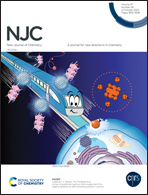Bi-functional role of high charge mobility with 2D/2D interactions for effective PEC and visible photocatalysis in NiO/MoS2 nanocomposites
Abstract
Highly efficient 2D/2D layered heterostructure of nickel oxide (NiO) and molybdenum sulphide (MoS2) has been fabricated for the photoelectrochemical (PEC) water splitting and degradation of Bromophenol Blue (BPB) under visible light. The XRD spectra confirm mixed characteristic peaks of MoS2 and NiO in the nanocomposite. SEM displays flower-like patterns of pure and composite material with the 2D nanosheets layer structure. The band gap reduction (2.25–1.72 eV) is due to the incorporation of NiO in MoS2 for visible light harvesting. TEM confirms the homogeneous distribution of 2D/2D nanosheets. The excellent interfacial coupling in strong 2D/2D interactions boost the electro and photocatalytic activities. 15.0% NiO showed excellent PEC activity toward OER with maximum photocurrent density of 1.57 mA cm−2, which influenced the overall water splitting at lower potential, ensuring visible photoresponse. The maximum photodegradation performance for highly toxic BPB was achieved by the photocatalyst, which contains 15.0 wt% NiO in NiO/MoS2 composite. It displays the highest conversion efficiency (∼87.0%) for BPB owing to exposed active sites via Mo–Ni–S linkages. Defects in NiO/MoS2 offer favorable reaction dynamics to PEC OER, which are helpful in tuning the band potentials.



 Please wait while we load your content...
Please wait while we load your content...